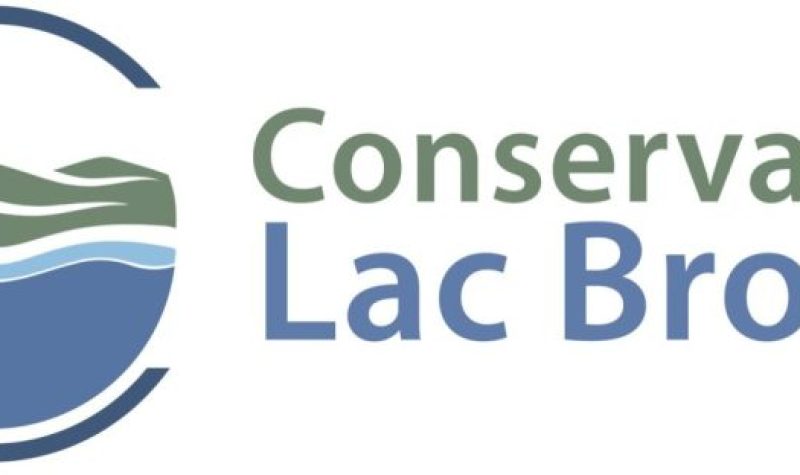In 1961, a group of residents came together to sound the alarms on the state of Brome Lake (water body), considered the “crown jewel” of the Brome Lake municipality. At the time, the lake was facing frequent cyanobacteria outbreaks.
Together, these residents established the Brome Lake Conservation Association to take action. The association was one of the first organizations dedicated to lake protection in Quebec and was created before the Ministry of Environment.
In 2001, the organization found a new name in Renaissance Lac-Brome (RLB); a name that reflected what it deemed as the necessary “rebirth” of the lake and one that the group has stuck with for the last two decades, until now.
As of yesterday, what was formerly known as RLB will now be Conservation Lac-Brome (CLB). The new name is accompanied by a new logo after board members decided that the organization was in need of a rebranding.
“The question arose a few years ago, a lot of people didn’t know what we were doing. RLB didn’t mean much to people. People that are used of RLB that were here in Knowlton or Brome Lake for a while knew us, but the new residents here didn’t know us,” noted Jean-Pierre Pilon, president of CLB.
With the word “renaissance” now often incorporated in the names of businesses, senior’s residences, charities, etc., Pilon said that “the mission that we have and what we are concerned of wasn’t integrated in the name.”
“Just looking at the other organizations that take care of lakes, their name is really in align with their mission. So, we decided to change the name because it was more confusing than anything,” added Pilon. “Conservation Lac-Brome is not something we took out of the basket. We’re going back to the name that the founders of this organization gave to it in ’61.”
In terms of the new logo, Pilon mentioned that CLB wanted something more “modern” and that would “speak to the people.”
“A lake by itself doesn’t exist. You need a watershed and the watershed that we have, 185 km of watershed, goes as far as Sainte-Étienne-de-Bolton to South Stukely,” he explained. “(…) The logo, if you look at it, you see water coming from the mountain, coming from the watershed, and going into the lake.”
With this rebranding comes new objectives and a change in the organization's strategic plan.
“We think that our organization has focused a lot on studies in the past. We’re monitoring the quality of the water and we’re trying to reach out to people to tell them what’s going on with the lake. We think we have to do it a bit more,” said Pilon. “It’s not a matter of one organization to change things. I think that everyone can do, at their level, changes to improve the quality of the water of the lake.”
Pilon mentioned that the organization is in the process of reviewing its strategic plan that will focus on education, collaboration, and cooperation with the community.
“The rebranding in itself will speak more, but it’s not the hand. It’s a new beginning, we are going back to what the organization was in the past, and it’s in line with what we want to do. By changing the name we don’t expect to have people coming to us, we have to go and see the community,” he said.
Last year, the group made a presence at the local farmer’s market, it collaborated with the Knowlton Boat Club to give lessons to students at both the local elementary schools, and it organized different community events; something that CLB wants to build on.
“We have a budget of around $125,000. Each year we are doing a lot of projects. Monitoring the lake is part of it, but we’re doing projects to improve the quality of the water,” noted Pilon. “We are working closely with the town as well.”
Pilon explained that even though Brome Lake is in better shape than it was back in the 70s and 80s, it hasn’t made things easier for the organization.
“At the time, they had point source pollution (specific spots on the lake). The sewers weren’t built yet, we didn’t have the technology, we didn’t have the knowledge, it wasn’t the same,” he said. “(…) The point sources were recognizable. Nowadays, we’re talking about non-point source; it’s all over the place. It’s the reason why we need the community to participate in this endeavour.”
A major focus for CLB is reducing the phosphorus that enters the lake, this involves reducing what Pilon refers to as the “nutrient budget,” and preserving the riparian line around the lake.
“The scientists that looked at the lake back in the 80s and 90s, they were telling us, as a community, ‘your lake is feeding itself. You have so much phosphorus.’ (…) We haven’t succeeded yet to reduce the phosphorus coming in,” mentioned Pilon.
The goal for CLB is to transform the knowledge communicated to the community into action.
“It’s a matter of having awareness and to teach them what they can do. Demonstrate that even the smallest change could help the lake,” said Pilon.
A membership campaign will be launched by CLB in the upcoming months. For more information on CLB and what it means to become a member visit the website.
Listen to the full interview below:


